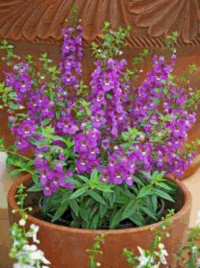
Perennial Care
Our long growing season and sporadic summer storms can produce abundant and even rampant growth during the summer.
Tall plants can shade out or fall over onto smaller plants, and some plants will spread into areas where they were not intended to grow.
Be sure to observe problems you see with your plantings and make decisions on what to remove, divide or transplant this fall. In the meantime, however, follow these tips for summer care:
+Prune overgrown perennials, especially those that bloom over a long period and well into the fall.
+ Stake or otherwise support larger perennials that need it. If young children will be playing around the garden, the stakes should be taller than the children to avoid injury.
+ Straighten any leaning plants and wedge a piece of brick or stone at the base of each. This will support the plant and help it grow more upright but won’t be too visible.
+ Many perennials spread by underground stems – some fast, some slow. Promptly dig out unwanted growth outside the area allotted to the plant and pot it up, replant it somewhere else or throw it away. Barriers extending 8 to 12 inches down into the ground around aggressive spreaders can help keep them under control.
+Louisiana irises are semi-dormant during late summer. Prune off seedpods and yellow or brown foliage to help keep the plants more attractive. You may transplant or divide Louisiana irises beginning in August.
+Prune azaleas no later than mid-July. Pruning azaleas after early to midsummer may remove next season’s developing flower buds. This applies to many spring-flowering shrubs as well as hydrangeas and gardenias.
Pentas Among Best Plants for Butterfly Gardens
Pentas (Pentas lanceolata) are among the best summer bedding plants for butterfly gardens, and nothing beats the Butterfly strain of pentas.
These great summer bedding plants will produce clusters of flowers in shades of pink, white, red and lavender all through the summer. The Butterfly pentas is a 2011 Louisiana Super Plants selection, so you know it has a proven track record of garden performance all across Louisiana.
Other excellent nectar plants for butterfly gardens include Mexican butterfly weed (Asclepias curassavica), coneflower (Echinacea purpurea), butterfly bush (Buddleia species), lantana (Lantana camara, L. montevidensis) and salvias (Salvia species).
Serena Angelonias
The development of outstanding types of angelonias is one of the best things to happen to Louisiana flower gardens, and the Serena angelonias is one of the latest plants to be selected for the Louisiana Super Plants designation.
Showing the excellent heat and humidity tolerance that is so critical to success in our area, angelonias are tender herbaceous perennials that generally are grown as annuals. They are bushy plants with narrow, dark green foliage and spikes of attractive flowers in various colors. They may be planted during summer and will bloom until the first hard freeze.
Growing only 12 to 18 inches tall, Serena angelonias are among the most compact. The strain provides an excellent selection of colors, including Serena Lavender, Serena Lavender Pink, Serena White and Serena Purple. These angelonias are absolutely some of the very best bedding plants around.
Serena angelonias will grow best in well-prepared beds amended with organic matter and a light fertilizer application, just as you would do for other bedding plants. Since they thrive in heat, you can add them to your gardens anytime during the summer. Full to part sun (six to eight hours of direct sun daily) will produce stocky plants with plenty of flower spikes. Avoid areas that are too shady.
Once established, however, Serena angelonias are somewhat drought tolerant and hang tough during hot, dry weather. They have no major insect or disease problems in our state.
Horticulture Hints
Summer Vegetables
July is the time to transplant tomatoes and bell peppers in mid-July for fall production. Plant okra, southern peas, cucumbers, squash, cantaloupes, pumpkins and watermelons.
Mid- to late July: Seed broccoli, Brussels sprouts, cauliflower, Chinese cabbage, cabbage, collards and winter squash. You can still transplant bell peppers and tomatoes.
Cabbage can be seeded beginning in mid-July and seed through September. You also may transplant beginning in early August through mid-October. Fertilize the same as broccoli and cauliflower. Space cabbage, cauliflower and Chinese cabbage about 12 to 14 inches apart and broccoli 6 to 12 inches apart. Double drills (two drills of plants spaced 10-12 inches apart on a single row) will help maximize yield. Try Rio Verde for late plantings. Recommended early maturity varieties include Platinum, Dynasty, Gold Dynasty and Stonehead (AAS). Maturing a little later are Rio Verde, Solid Blue 780, Red Dynasty, Emblem, Blue Dynasty, Thunderhead Royal Vantage, Silver Dynasty, Blue Thunder, Cheers, Vantage Point, Savoy Ace (AAS) and Savoy King (AAS).
Broccoli and cauliflower can be direct-seeded beginning in mid-July through September or transplanted from early August through early September. It takes four to six weeks to produce transplants from seed. In general, broccoli and cauliflower will require 5 to 6 pounds (or pints) of a complete fertilizer such as 8-24-24 or 13-13-13 per 100 feet of row. These crops, especially cauliflower, require fast, continuous growth for proper head development. Keep them well watered and fertilized. Side-dress plants with ¾ pound (1 ½ cups) of ammonium nitrate per 100 feet of row three to four weeks after transplanting and again two weeks after that. Varieties that will produce in about 60 days from transplanting reduce the chance of cold-weather damage. Recommended varieties are:
| Broccoli ArcadiaGypsy Diplomat Packman |
Cauliflower MajesticCandid Charm Cumberland Snow Crown Freedom |
submitted by Karen Blackburn
